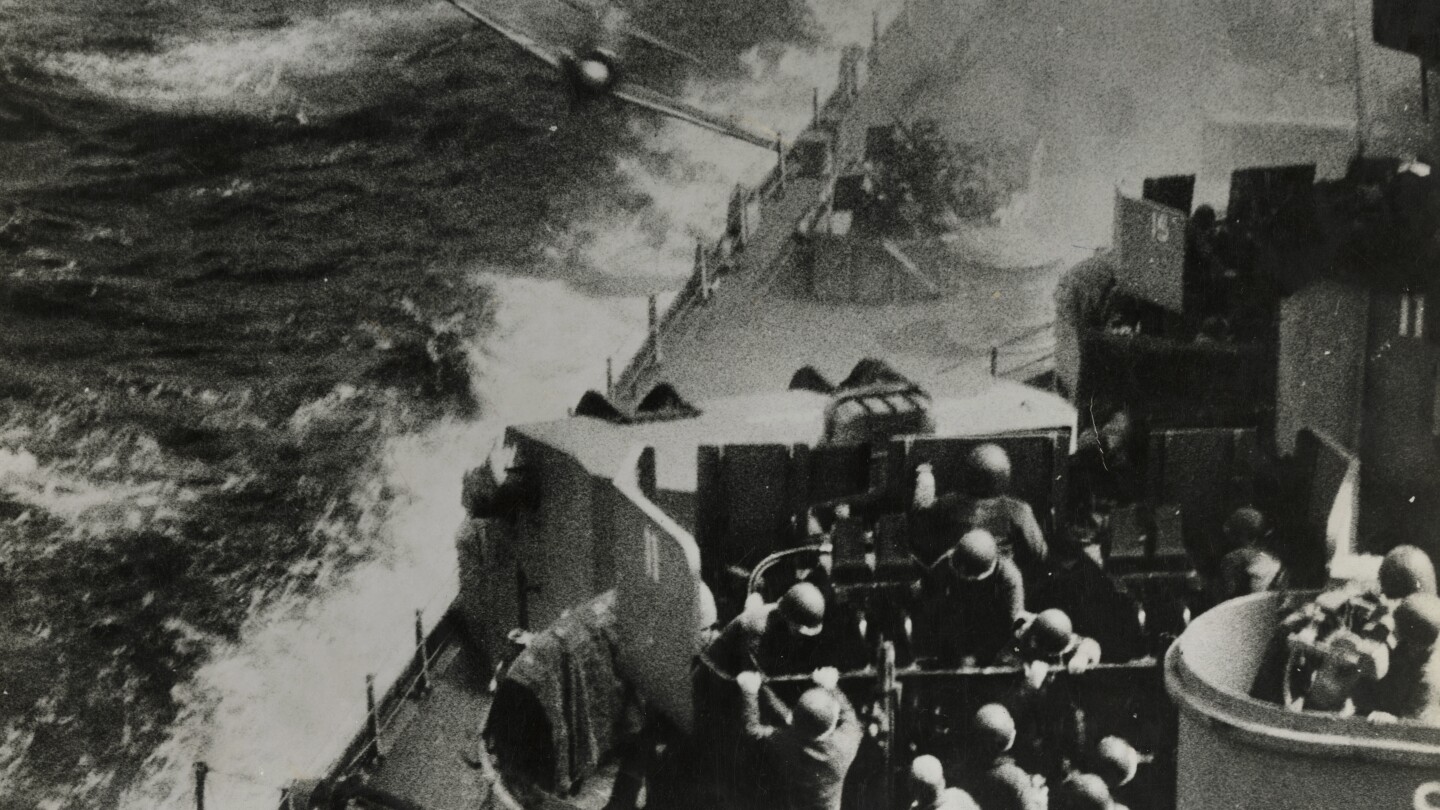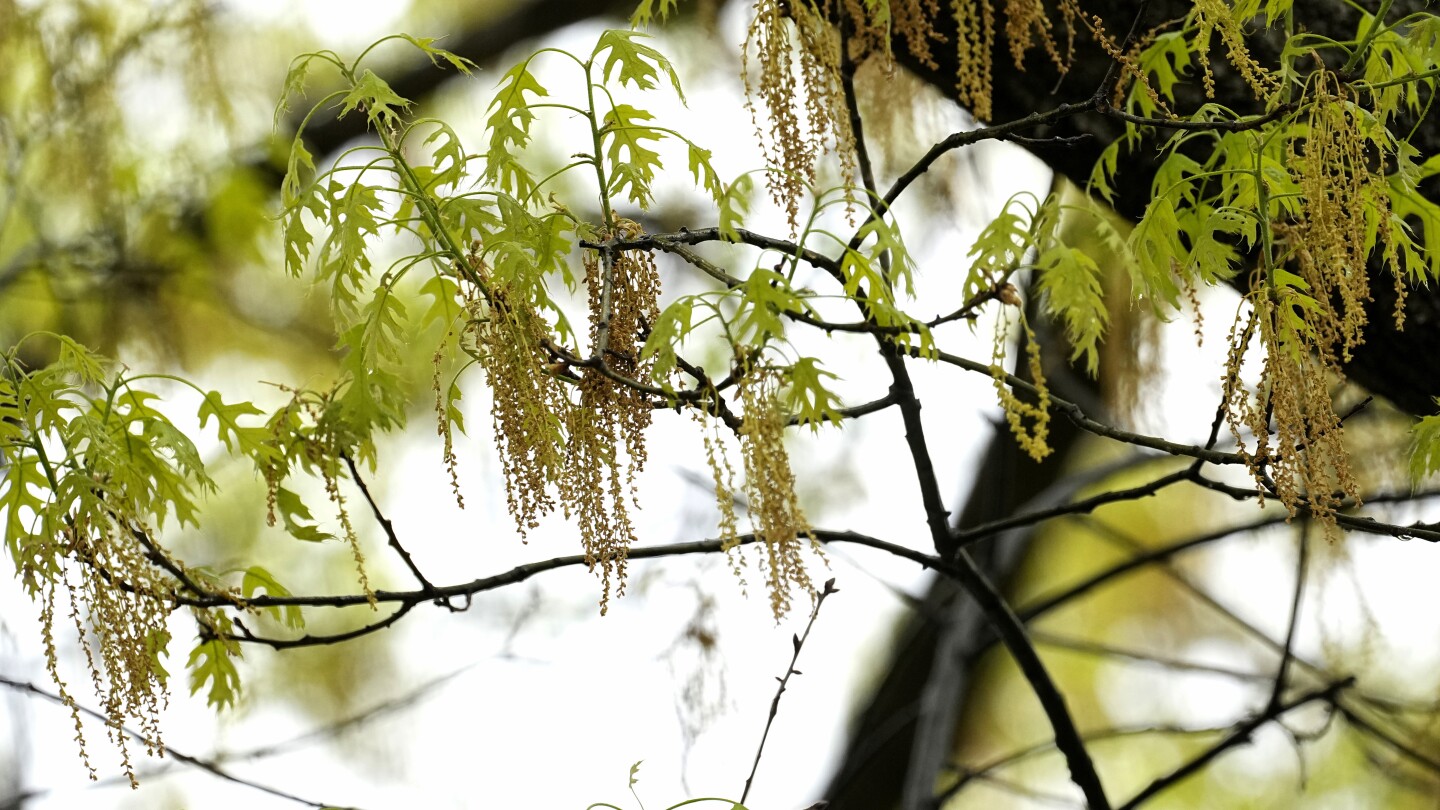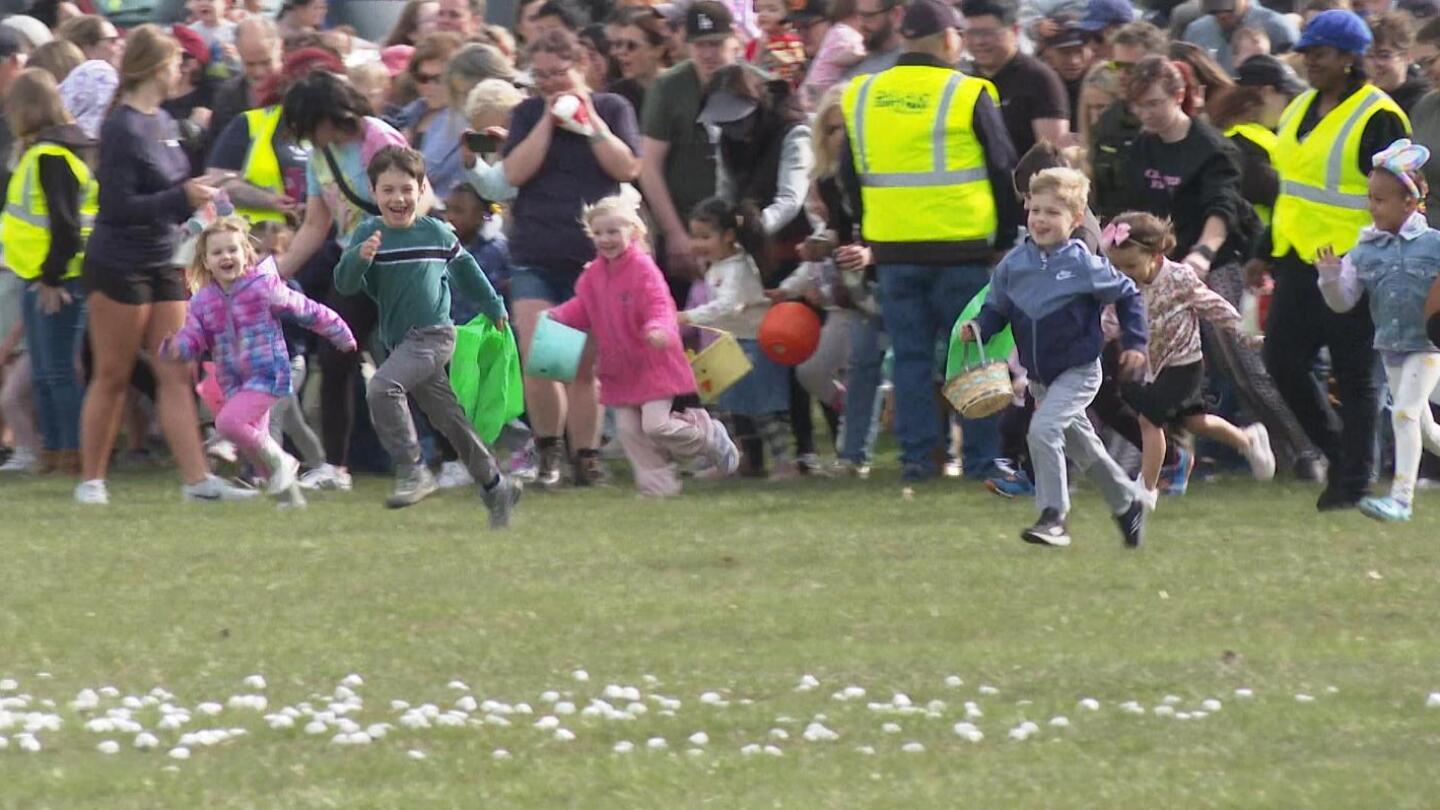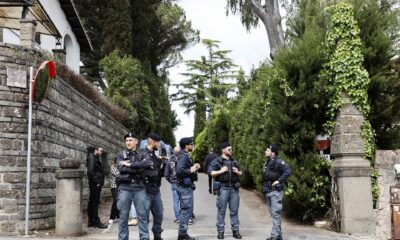Lifestyle
A US Navy captain ordered a military funeral for a kamikaze pilot during WWII. Here’s why

PEARL HARBOR, Hawaii (AP) — A Japanese pilot slammed his Zero fighter plane into the USS Missouri and ignited a fireball on April 11, 1945, during the Battle of Okinawa. The suicide attack instantly killed the pilot, but none of the battleship’s crew members were badly hurt.
The Missouri’s captain ordered a military burial at sea with full honors, marking one of the more unusual and little-known episodes of World War II. The pilot received the same funeral that the ship would have given one of its own sailors.
Eighty years later, the Missouri is a museum moored at Pearl Harbor, Hawaii, not far from the submerged hull of the USS Arizona, which sank in the 1941 Japanese bombing that propelled the U.S. into the war. On Friday, three of the captain’s grandsons will mark the anniversary of the attack and burial with the mayors of Honolulu and the Japanese city of Minamikyushu, from which many kamikaze pilots set off on their suicide missions.
“This is one of the ship’s great stories and explains, in part, why the ship became an international symbol of peace and reconciliation within two years of its launching and rather than just an instrument of destruction,” said Michael Carr, CEO of the Battleship Missouri Memorial. “This is a remarkable story of compassion and humanity, even in the midst of one of the worst battles of World War II.”
Here’s what to know about the attack on the Missouri and the pilot’s burial:
What is a kamikaze pilot?
Japan launched a suicide attack campaign as a last-ditch measure to push U.S. forces back late in the war, when it was hopelessly losing.
The Imperial Navy founded the Kamikaze Tokko Tai, which translates as Divine Wind Special Attack Corps, and the Imperial Army followed with its own unit. Internationally their missions are called kamikaze, but in Japan they are better known as “tokko,” which means “special attack.”
The pilots flew hastily constructed planes and even reconnaissance and training aircraft because the military lacked sufficient equipment. They took off on one-way flights with just enough fuel to reach their targets.
Kamikaze sank their first ship on Oct. 25, 1944, when a navy Zero pilot smashed into the USS St. Lo in the Philippine Sea while carrying a pair of 550-pound (250-kilogram) bombs. Britain’s Imperial War Museum says they killed 7,000 Allied naval personnel in all.
Their initial 30% success rate fell to about 8% by mid-1945 due to declining crew skills, dwindling aircraft capabilities and improved U.S. defenses.
Some 4,000 pilots died on suicide missions, about 2,500 navy and more than 1,400 army, most of them university students drafted in late 1943. Many launched from Chiran, a tea farming town that today is part of Minamikyushu, a city in southwest Japan.
The missions became more intense as Japan’s outlook grew more dire and the military showcased the sacrifice of the pilots to drum up patriotism and support for the war. Those who failed to take off or survived were considered a disgrace.
Despite stereotypes of kamikaze as super-patriots who volunteered to die, many were not, as shown by their carefully nuanced last letters to loved ones and survivor accounts.
“They were victims of war,” said Hiroyuki Nuriki, mayor of Minamikyushu, who noted the pilots were only around 20 years old and had futures.
“I’m sure they didn’t want to die, but they still had to go,” he said. “That’s the tragedy of war, and that’s why we should never start a war again.”
What happened when the plane hit the Missouri?
The Battle of Okinawa lasted 82 todays, with fierce fighting on land and sea. On April 11 the Missouri fended off aerial assaults from multiple directions and already had downed one kamikaze plane when a second approached.
Anti-aircraft fire peppers the sky and sea as a Japanese Zero fighter plane heads towards the USS Missouri that was operating off Okinawa, Japan, on April 11, 1945. (U.S. National Archives photo no. 80-G-315812 via AP)
The Missouri’s gunners hit the Zero fighter with a 5-inch (12.7-centimeter) round. The plane plunged, but it leveled out about 20 feet (6 meters) above the ocean and headed for the ship’s starboard side.
The crash ripped off the plane’s right wing, which landed on the deck. Fuel in the wing caught fire, unleashing a giant plume of smoke. The crew controlled the fire within five minutes.
The dent left by the attack is still visible on the Missouri’s hull.
This April 3, 2025, photo taken at the Battleship Missouri Memorial in Pearl Harbor, Hawaii shows damage sustained when a Japanese Zero fighter flown by a kamikaze pilot rammed into the USS Missouri during the Battle of Okinawa on April 11, 1945. (AP Photo/Audrey McAvoy)
What happened to the pilot?
Capt. William Callaghan ordered the funeral to be held the next morning.
The crew collected red and white cloth and sewed a makeshift “rising sun” flag so he could be buried under his own colors, said Frank Clay, curator of the Battleship Missouri Memorial. They cleaned the body, wrapped it in canvas and placed it on a tray against the rail beneath the flag.
Marine rifle guards gave a gun salute and a bugler played taps. The chaplain gave an invocation and said, “Commit his body to the deep.” The crew tipped the tray and the body slid into the sea.
It was the only known instance of U.S. forces holding a military funeral for a kamikaze pilot.
U.S. service members prepare a burial at sea for the remains of a Japanese pilot whose plane hit the USS Missouri on April 11, 1945. (U.S. National Archives photo no. 80-G-315823 via AP)
Some crew members resented the ritual, while others grumbled but later came to believe it was the right thing to do, Clay said.
Ed Buffman, who was a teenage gunner’s mate 2nd class on the Missouri, said he did not dwell on it: “The next day you’re ready to go back and battle again.”
Little is known of Callaghan’s reasons for ordering the ceremony, which appeared on the ship’s daily schedule for meal times and other routine activity.
Carey Callaghan said his grandfather never spoke of the burial and his family didn’t learn about it until 2001. He said his grandfather had empathy and a sense of dignity, which was reflected by the funeral.
A remarkable thing, Callaghan said, was that three years earlier, his grandfather lost his brother, Rear Adm. Daniel Callaghan, to Japanese gunfire off Guadalcanal.
What is known about the pilot?
Scholars believe he was Setsuo Ishino, a petty officer 2nd class in a flight training program.
The pilot took off from Kanoya air base in southern Japan with 15 others as part of the No. 5 Kenmu Squadron. Most failed to hit their targets and crashed into the ocean.
“Dear Mother, The time has come for me to blossom at last. I am fulfilling my final duty with a smile. Please don’t say anything, this is for our country,” Ishino wrote. “The next time we see each other, we will be under the beautiful cherry blossom trees at Yasukuni Shrine. Please don’t cry, only smile and tell me ‘well done.’”
Why is the anniversary being remembered decades later?
Then-President Barack Obama referenced the burial in 2016 when he visited Pearl Harbor with then-Prime Minister Shinzo Abe. He told those gathered that Callaghan showed “we must resist the urge to demonize those who are different” and do so “even when hatred burns hottest.”
Thanks to Callahan’s act, the Missouri museum and the Chiran Peace Museum, which displays army tokko artifacts, today are partners and help each other with exhibits.
Nuriki, the Minamikyushu mayor, said it is important to remember the events of April 11, 1945, and the tragedy of kamikaze pilots as Asia-Pacific tensions rise.
“We share the history between the former enemies that have become friends,” he said. “We should keep telling the story and think about peace.”
___
Yamaguchi reported from Tokyo.
Lifestyle
Allergy season: How to check pollen levels and alleviate symptoms

ATLANTA (AP) — Allergy season can be miserable for tens of millions of Americans when trees, grass, and other pollens cause runny noses, itchy eyes, coughing and sneezing.
Where you live, what you’re allergic to and your lifestyle can make a big difference when it comes to the severity of your allergies. Experts say climate change is leading to longer and more intense allergy seasons, but also point out that treatments for seasonal allergies have become more effective over the last decade.
Here are some tips from experts to keep allergy symptoms at bay — maybe even enough to allow you to enjoy the outdoors.
Where are pollen levels the worst this year?
The Asthma and Allergy Foundation of America issues an annual ranking of the most challenging cities to live in if you have allergies, based on over-the-counter medicine use, pollen counts and the number of available allergy specialists.
This year, the top five cities are: Wichita, Kansas; New Orleans; Oklahoma City; Tulsa, Oklahoma; and Memphis.
Which pollens cause allergies?
There are three main types of pollen. Earlier in the spring, tree pollen is the main culprit. After that grasses pollinate, followed by weeds in the late summer and early fall.
Some of the most common tree pollens that cause allergies include birch, cedar, cottonwood, maple, elm, oak and walnut, according to the Asthma and Allergy Foundation of America. Grasses that cause symptoms include Bermuda, Johnson, rye and Kentucky bluegrass.
This article is part of AP’s Be Well coverage, focusing on wellness, fitness, diet and mental health. Read more Be Well.
How do I track pollen levels?
Pollen trackers can help you decide when to go outside. The American Academy of Allergy Asthma and Immunology tracks levels through a network of counting stations across the U.S. Counts are available at its website and via email.
Limit your exposure to pollens
The best and first step to controlling allergies is avoiding exposure. Keep the windows in your car and your home closed, even when it’s nice outside.
If you go outside, wearing long sleeves can keep pollen off your skin to help ward off allergic reactions, said Dr. James Baker, an allergist at the University of Michigan. It also provides some sun protection, he added.
When you get home, change your clothes and shower daily to ensure all the pollen is off of you — including your hair. If you can’t wash your hair every day, try covering it when you go outside with a hat or scarf. Don’t get in the bed with your outside clothes on, because the pollen will follow.
It’s also useful to rinse your eyes and nose with saline to remove any pollen, experts said. And the same masks that got us through the pandemic can protect you from allergies — though they won’t help with eye symptoms.
How to relieve allergy symptoms
Over-the-counter nasal sprays are among the most effective treatments for seasonal allergies, experts said.
But the vast majority of patients use them incorrectly, irritating parts of the nose, said Dr. Kathleen Mays, an allergist at Augusta University in Georgia. She suggested angling the nozzle outward toward your ear rather than sticking it straight up your nose.
Over-the-counter allergy pills like Claritin, Allegra and Zyrtec are helpful, but may not be as effective as quickly since they’re taken by mouth, experts said.
Experts also said that if your allergy symptoms are impacting your quality of life, like causing you to lose sleep or a lack focus at work or school, it might be time to consider an allergist appointment for immunotherapies.
Some remedies for allergy relief that have been circulating on social media or suggested by celebrities — like incorporating local honey into your diet to expose yourself to pollen — have been debunked.
Dr. Shayam Joshi, an allergist at Oregon Health and Science University, said that’s because the flowers that bees pollinate typically don’t contain the airborne pollen that causes allergy symptoms.
Is allergy season changing?
With climate change, winters are milder and growing seasons are longer, meaning there’s more opportunity for pollen to stay in the air, resulting in longer and more severe allergy seasons.
In many areas across the country, pollen counts have broken decades of records. In late March, the Atlanta Allergy and Asthma Center measured a pollen count of over 14,000 grains per cubic meter, which is considered extremely high.
___
The Associated Press Health and Science Department receives support from the Howard Hughes Medical Institute’s Science and Educational Media Group and the Robert Wood Johnson Foundation. The AP is solely responsible for all content.
Lifestyle
The 250th anniversary of the Battles of Lexington and Concord opens debate over US independence
NEW YORK (AP) — The American Revolution began 250 years ago, in a blast of gunshot and a trail of colonial spin.
Starting with Saturday’s anniversary of the Battles of Lexington and Concord, the country will look back to its war of independence and ask where its legacy stands today.
The semiquincentennial comes as President Donald Trump, the scholarly community and others divide over whether to have a yearlong party leading up to July 4, 2026, as Trump has called for, or to balance any celebrations with questions about women, the enslaved and Indigenous people and what their stories reveal.
The history of Lexington and Concord in Massachusetts is half-known, the myth deeply rooted.
What exactly happened at Lexington and Concord?
Reenactors may with confidence tell us that hundreds of British troops marched from Boston in the early morning of April 19, 1775, and gathered about 14 miles (22.5 kilometers) northwest on Lexington’s town green.
Firsthand witnesses remembered some British officers yelled, “Thrown down your arms, ye villains, ye rebels!” and that amid the chaos a shot was heard, followed by “scattered fire” from the British. The battle turned so fierce that the area reeked of burning powder. By day’s end, the fighting had continued around 7 miles (11 kilometers) west to Concord and some 250 British and 95 colonists were killed or wounded.
But no one has learned who fired first, or why. And the revolution itself was initially less a revolution than a demand for better terms.
Woody Holton, a professor of early American history at the University of South Carolina, says most scholars agree the rebels of April 1775 weren’t looking to leave the empire, but to repair their relationship with King George III and go back to the days preceding the Stamp Act, the Tea Act and other disputes of the previous decade.
“The colonists only wanted to turn back the clock to 1763,” he said.
Stacy Schiff, a Pulitzer Prize winning historian whose books include biographies of Benjamin Franklin and Samuel Adams, said Lexington and Concord “galvanized opinion precisely as the Massachusetts men hoped it would, though still it would be a long road to a vote for independence, which Adams felt should have been declared on 20 April 1775.”
But at the time, Schiff added, “It did not seem possible that a mother country and her colony had actually come to blows.”
A fight for the ages
The rebels had already believed their cause greater than a disagreement between subjects and rulers. Well before the turning points of 1776, before the Declaration of Independence or Thomas Paine’s boast that “We have it in our power to begin the world over again,” they cast themselves in a drama for the ages.
The so-called Suffolk Resolves of 1774, drafted by civic leaders of Suffolk County, Massachusetts, prayed for a life “unfettered by power, unclogged with shackles,” a fight that would determine the “fate of this new world, and of unborn millions.”
The revolution was an ongoing story of surprise and improvisation. Military historian Rick Atkinson, whose “The Fate of the Day” is the second of a planned trilogy on the war, called Lexington and Concord “a clear win for the home team,” if only because the British hadn’t expected such impassioned resistance from the colony’s militia.
The British, ever underestimating those whom King George regarded as a “deluded and unhappy multitude,” would be knocked back again when the rebels promptly framed and transmitted a narrative blaming the royal forces.
“Once shots were fired in Lexington, Samuel Adams and Joseph Warren did all in their power to collect statements from witnesses and to circulate them quickly; it was essential that the colonies, and the world, understand who had fired first,” Schiff said. “Adams was convinced that the Lexington skirmish would be ‘famed in the history of this country.’ He knocked himself out to make clear who the aggressors had been.”
A country still in progress
Neither side imagined a war lasting eight years, or had confidence in what kind of country would be born out of it. The founders united in their quest for self-government but differed how to actually govern, and whether self-government could even last.
Americans have never stopped debating the balance of powers, the rules of enfranchisement or how widely to apply the exhortation, “All men are created equal.”
“I think it’s important to remember that the language of the founders was aspirational. The idea that it was self-evident all men were created equal was preposterous at a time when hundreds of thousands were enslaved,” said Atkinson, who cites the 20th-century poet Archibald MacLeish’s contention that “democracy is never a thing done.”
“I don’t think the founders had any sense of a country that some day would have 330 million people,” Atkinson said. “Our country is an unfinished project and likely always will be.”
Lifestyle
Sweets from the sky! A helicopter marshmallow drop thrills kids in suburban Detroit

ROYAL OAK, Mich. (AP) — It’s spring in Detroit — warm weather, a few clouds, and a 100% chance of marshmallow downpours.
The source? A helicopter zooming above the green lawn of Worden Park on Friday, unloading sack-fulls of fluffy treats for hundreds of kids waiting eagerly below, some clutching colorful baskets or wearing rabbit ears.
The children cheered and pointed as the helicopter clattered by on its way to the drop zone. Volunteers in yellow vests made sure kids didn’t rush in and start grabbing marshmallows until after the deluge was complete.
For anyone worried about hygiene, don’t fret. The annual Great Marshmallow Drop isn’t about eating the marshmallows — kids could exchange them for a prize bag that included a water park pass and a kite.
The marshmallow drop has been held for over three decades in the Detroit suburb of Royal Oak, Michigan, hosted by Oakland County Parks.
One toddler, Georgia Mason, had no difficulty procuring a marshmallow at her first drop, her dad Matt said.
“Probably the most exciting part was seeing the helicopters. But once we saw the marshmallows drop, we got really excited,” Matt Mason said.
“And, yeah, we joined the melee,” he said, “We managed to get one pretty easy.”
Organizers said 15,000 marshmallows were dropped in all.
The helicopter made four passes, dropping marshmallows for kids in three age categories: 4-year-olds and younger, 5-7-year-olds, and those ages 8 to 12. A drop for kids of all ages with disabilities came later in the day.
“We do it because it’s great for community engagement,” Oakland County recreation program supervisor Melissa Nawrocki said.
“The kids love it,” she continued. “The looks on their faces as they’re picking up their marshmallow and turning in the marshmallow for prizes is great.”
-

 Education1 day ago
Education1 day agoHarvard’s battle with the Trump administration is creating a thorny financial situation
-

 Sports2 days ago
Sports2 days agoAaron Rodgers ‘not holding anybody hostage’ as he decides his future, retirement a possibility
-

 Europe1 day ago
Europe1 day agoTrump’s ‘lone ranger’: How Steve Witkoff became the defacto point man on America’s foreign policy challenges
-

 Middle East7 hours ago
Middle East7 hours agoIran says progress in nuclear talks with US, confirms third round next week | News
-

 Middle East15 hours ago
Middle East15 hours agoTunisian court hands opposition figures lengthy jail terms | Human Rights News
-

 Conflict Zones1 day ago
Conflict Zones1 day agoTrump says US may ‘pass’ on helping end war if Russia, Ukraine resist deal | Russia-Ukraine war News
-

 Europe1 day ago
Europe1 day agoThe Trump administration says Europe is taking advantage of the US. That’s not exactly true
-

 Lifestyle1 day ago
Lifestyle1 day agoSweets from the sky! A helicopter marshmallow drop thrills kids in suburban Detroit



